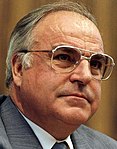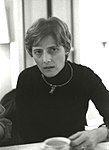1983 West German federal election
| |||||||||||||||||||||||||||||||||||||||||||||||||||||||||||||||||
All 520 seats in the Bundestag 261 seats were needed for a majority | |||||||||||||||||||||||||||||||||||||||||||||||||||||||||||||||||
|---|---|---|---|---|---|---|---|---|---|---|---|---|---|---|---|---|---|---|---|---|---|---|---|---|---|---|---|---|---|---|---|---|---|---|---|---|---|---|---|---|---|---|---|---|---|---|---|---|---|---|---|---|---|---|---|---|---|---|---|---|---|---|---|---|---|
| Turnout | 89.1% (voting eligible)[1] | ||||||||||||||||||||||||||||||||||||||||||||||||||||||||||||||||
| |||||||||||||||||||||||||||||||||||||||||||||||||||||||||||||||||
 Party list election results by state: dark blue denotes states where CDU/CSU had the absolute majority of the votes; lighter blue denotes states where CDU had the plurality of votes; and pink denotes states where the SPD had the plurality of votes | |||||||||||||||||||||||||||||||||||||||||||||||||||||||||||||||||
| |||||||||||||||||||||||||||||||||||||||||||||||||||||||||||||||||
| This article is part of a series on the |
| Politics of Germany |
|---|
 |
German federal elections took place on 6 March 1983, to elect members to the 10th Bundestag (parliament) of the Federal Republic of Germany.
Issues and campaign
In October 1982 CDU chairman Helmut Kohl was elected Chancellor by a CDU/CSU and FDP majority in the Bundestag, while the FDP in 1980 still was on the side of the SPD. Early elections were arranged. The SPD encountered difficulties because on the left a new party was emerging, the Greens.
A major issue in this election was the armament question after the NATO Double-Track Decision.
Results
Template:German federal election, 1983
| 255 | 35 | 202 | 28 |
| CDU/CSU | FDP | SPD | Grüne |

Post-election
The coalition between the CDU/CSU and the FDP returned to government, with Helmut Kohl as Chancellor. This was the first election in which the Greens secured representation in the Bundestag, and the first which saw a fourth (fifth) party in the parliament since 1960.
References
- ^ "Voter turnout by election year". Website of the Federal Returning Officer's Office. The Federal Returning Officer. Retrieved 7 November 2014.




